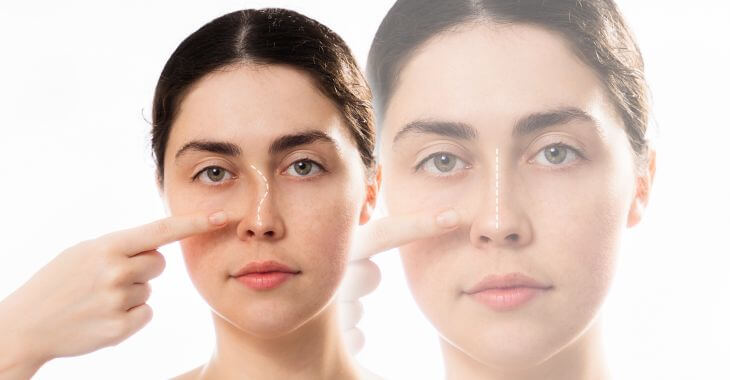Symmastia – What Are the Causes and Treatments?

Breasts of all sizes and shapes have one thing in common – cleavage, the space between the two breasts. Each breast has its own capsule and space, leaving a distinct vertical separation at the breastbone that defines the two entities. When this separation between the breasts is broken, merging the breasts together, it is due to a rare condition called symmastia. Here is what you need to know about symmastia, including the causes and treatment options.
Causes and Symptoms of Symmastia
Symmastia, or merging of the breasts, can be caused by either a congenital deformity or as a complication to breast augmentation surgery. In either case, symmastia is rare, but it is more likely to be caused by elective breast surgery than a congenital condition. Symptoms of symmastia can include:
- Cleavage disappears – the skin and tissue stretch across both breasts
- Breasts seems too close together becoming a “uniboob” or “breast loaf”
- Skin and tissue on the chest are visibly separated from the breastbone
- Pain in the breast/chest area
Both congenital conditions and breast augmentation or implant surgery can cause symmastia. Certain congenital physical traits in the chest could put some patients at higher risk of symmastia if they undergo breast augmentation, but do not display symptoms of a congenital deformity.
Treatment of Congenital Symmastia
Congenital symmastia is very rare, but it can occur. The cause of this deformity is not known but it can impact the skin and breast tissue. Instead of the distinct valley between the breasts with the skin and tissue connected to the breast bone or sternum, the skin and tissue stretches between the breasts. Congenital symmastia can present differently than symmastia that is a complication of breast augmentation and treatment is also different.
Treatment is not necessarily needed for congenital symmastia. It is usually not as painful or uncomfortable as when it is acquired due to breast augmentation. However, women with the congenital form of symmastia may desire the appearance of cleavage. Plastic surgery is required to remove fatty tissue and alter the skin or breast tissue to obtain the desired appearance.
Preventing Breast Implant Symmastia
Symmastia is a rare complication of breast implant surgery and can usually be prevented. Choosing a highly experienced, skilled and accredited plastic surgeon is the first step in preventing symmastia and other complications of breast augmentation surgery. Placement of the implants too closely to the center of the chest or other improper placement can increase the risk of it – experienced plastic surgeons understand the correct techniques to use to prevent these complications.
The “uniboob” complication can also occur due to choosing breast implants that are too large or wide for the patient’s frame. The chest tissues and muscles can constrict the implants due to their size, resulting in “breast loafing” or the breast implants merging together. The plastic surgeon and patient should discuss the risks of symmastia before surgery – choosing implants that are suitable for the patient’s chest size and physical traits can help prevent this complication. Anyone who is considering large breast implants for their breast augmentation should carefully choose their plastic surgeon and discuss the possibility of this condition before having their surgery.

Correcting or Treating Implant Symmastia
For those who have it as a complication of breast augmentation, the only treatment to permanently correct the condition is plastic surgery. Bras can provide temporary separation for appearance, but they may not address discomfort or pain caused by this condition. A breast implant revision surgery is often required to address the common causes of symmastia after augmentation, which include:
- Subglandular complications. In breast augmentation surgeries that place the breast implant over the pectoral muscles (subglandular), symmastia can occur if too much breast tissue was removed from the cleavage area on the chest. Subglandular revision surgery can remove the implants and place them under the pectoral muscles.
- Submuscular complications. If the breast implants were placed under the pectoral muscles (submuscular), symmastia can be caused by a separation of the muscle and skin from the chest wall. Submuscular revision surgery can be used to repair the breast pocket to form a more natural-appearing separation of the breasts.
- Over-sized implant complications. If symmastia occurs due to breasts that are too large for the individual’s frame, implant replacement or removal surgery is required. The implants can be removed or replaced with small implants to create the desired cleavage and separation.
Other surgical options without revision breast surgery are breast fat removal or capsulorrhaphy. Liposuction or surgical breast fat removal can remove excess fatty tissue from between the breasts to create deeper cleavage. Capsulorrhaphy is a procedure that uses sutures to reposition and separate the implants.
Symmastia can impact the appearance of cleavage and the breasts, impacting body image and self-confidence for women with this condition. Visiting an experienced plastic surgeon who specializes in breast augmentation, implant and revision surgeries is the first step to finding the right treatment and solution.
The information provided on this website, including text, graphics, images, and other materials, is intended solely for informational purposes and should not be used as a substitute for professional medical advice, diagnosis, or treatment.



)